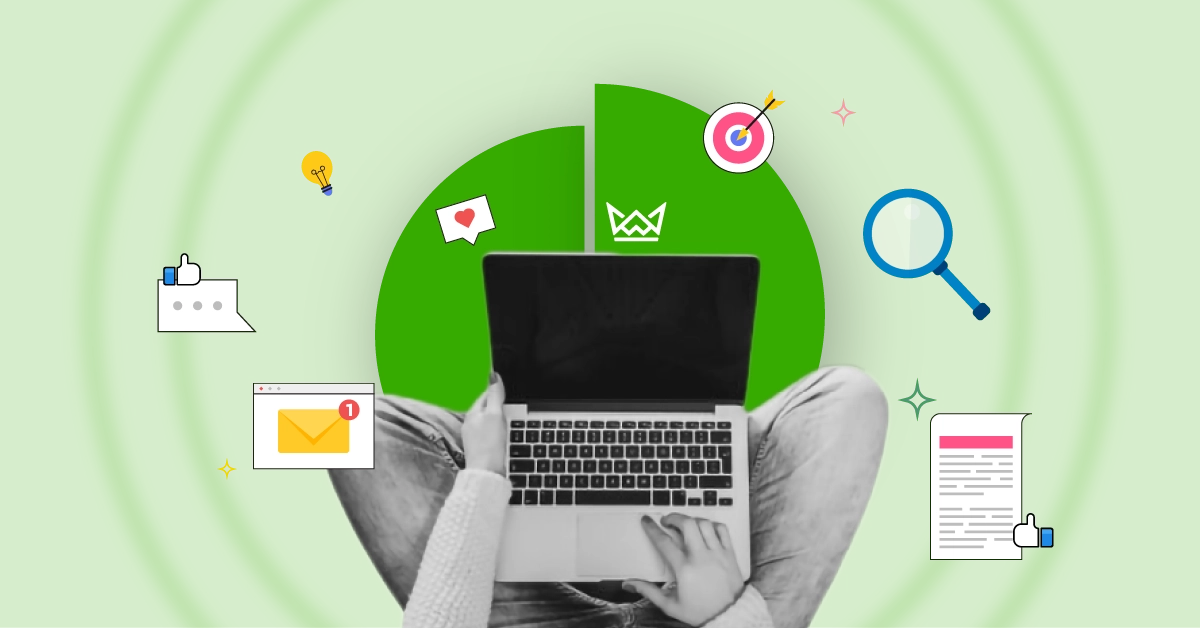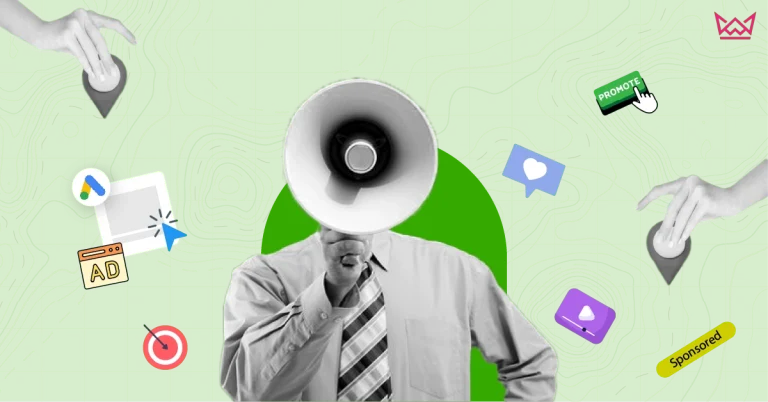Digital marketing is everywhere—on your phone, your laptop, and every time you Google something or scroll through Instagram. But what is digital marketing, really? In simple terms, it’s the way businesses promote their products or services using digital channels like websites, search engines, social media, email, and more.
Unlike old-school advertising, which relies on print or TV, digital marketing lets you connect directly with your audience online. You can track what’s working, adjust your plan, and reach people in real time. Whether you’re running a small business or launching a side hustle, digital marketing is the tool that helps you get noticed and grow fast.
It’s not just about running ads—it’s about understanding how to connect with the right people, at the right time, through the right platform.
What is Digital Marketing and How Does it Work?
Digital marketing refers to promoting brands, products, or services using online platforms and technologies. It combines creativity with data to reach audiences through search engines, websites, email, social media, and mobile apps.
So, how does digital marketing work? It usually starts with identifying your audience—who you want to reach. Then you choose the right channels (like Google Ads or Instagram), create relevant content, and launch campaigns. Tools like analytics and CRM software help track how people respond, so you can adjust your efforts in real-time.
At its core, digital marketing works on three principles: visibility (getting found), engagement (connecting meaningfully), and conversion (turning interest into action). Whether you want people to sign up, buy, or just know your brand exists—it’s all possible with digital marketing.
Types of Digital Marketing
Digital marketing is not a single channel or technique—it’s a combination of multiple strategies that work together to create awareness, build relationships, and drive sales. Below are the major types of digital marketing, explained in more detail:
1. Search Engine Optimization (SEO)
SEO focuses on improving your website’s ranking on search engines like Google. The goal is to appear higher in search results when someone searches for relevant terms. SEO involves:
- On-page SEO (optimizing content, headlines, images, and keywords)
- Off-page SEO (building backlinks and improving authority)
- Technical SEO (improving site speed, mobile-friendliness, and crawlability)
It takes time but can bring consistent, organic traffic without paying for ads.
2. Search Engine Marketing (SEM)
Search Engine Marketing, also known as paid search or PPC (Pay-Per-Click), allows your website to appear at the top of search results instantly through paid ads. You target specific keywords and only pay when someone clicks. Platforms like Google Ads and Bing Ads are popular choices.
SEM is especially useful for new websites or time-sensitive campaigns where fast visibility is important.
3. Content Marketing
This approach centers around creating and distributing valuable content to attract and retain a clearly defined audience.
Common formats include:
- Blog posts and articles
- Whitepapers and case studies
- Infographics
- Podcasts
- How-to videos
Content builds trust, educates prospects, and improves SEO rankings while positioning your brand as a thought leader.
4. Social Media Marketing (SMM)
SMM is about using social media platforms like Facebook, Instagram, Twitter, LinkedIn, and TikTok to promote your brand.
It involves:
- Sharing updates, tips, and behind-the-scenes moments
- Running paid ads and boosted posts
- Engaging with comments and DMs
- Creating viral or interactive content (polls, reels, stories)
It helps in building community, driving traffic, and boosting brand loyalty.
5. Email Marketing
Email is one of the most reliable channels to connect directly with your audience. It’s personal, targeted, and trackable. You can use it to:
- Welcome new subscribers
- Share product updates or offers
- Remind customers about abandoned carts
- Re-engage dormant users
Automation tools make it easy to run drip campaigns and personalize messages at scale.
6. Influencer Marketing
Here, you partner with influencers—people who have built trust and following in a niche. They promote your brand to their audience, often through social media or YouTube.
Micro-influencers (with 10k–50k followers) often deliver better engagement at lower costs than celebrities. This tactic is great for building brand awareness and trust quickly.
7. Affiliate Marketing
Affiliate marketing lets you grow your sales through a network of partners who promote your products or services in return for a commission.
Common affiliates include bloggers, content creators, or niche website owners. It’s a low-cost, performance-driven channel where you only pay for results.
8. Video Marketing
Video helps brands connect emotionally and explain products quickly. It works well across:
- YouTube
- Instagram Reels
- TikTok
- Facebook and LinkedIn videos
- Landing pages and product demos
From storytelling to testimonials, video marketing keeps users engaged and boosts conversion rates.
Each of these digital marketing types can work well alone, but combining them strategically creates a more powerful, full-funnel experience—from awareness to conversion.
Digital Marketing Strategy & Plan
A digital marketing strategy is the roadmap that connects your business goals to your online marketing actions. Without a strategy, your efforts are just tactics floating without direction. A clear plan helps you know where you’re going, why you’re going there, and how you’ll get results.
What Is Digital Marketing Strategy?
A digital marketing strategy outlines how a business will use digital channels to achieve specific goals. These goals could range from building brand awareness to generating leads or increasing online sales.
It involves choosing the right channels (like SEO, email, or social media), crafting the message for your audience, and deciding how to deliver that message effectively.
What Is Digital Marketing Plan?
The strategy is your “why” and “what.” The plan is your “how.”
A digital marketing plan is the execution blueprint. It details:
- What you’ll do (campaigns, content, ads)
- When you’ll do it (timelines and schedules)
- Where you’ll do it (channels and platforms)
- Who will do it (team members or tools)
- How you’ll measure success (KPIs and tools)
Steps to Build an Effective Digital Marketing Strategy and Plan
1. Set SMART Goals
Your strategy should begin with specific, measurable goals that align with your overall business objectives. SMART goals are:
- Specific: Know exactly what you’re trying to achieve, like increasing form submissions or eBook downloads.
- Measurable: Use numbers, such as reaching 10,000 monthly visitors or boosting conversions by 20%.
- Achievable: Set realistic goals based on your resources and timelines.
- Relevant: Ensure the goal supports your larger marketing or revenue objectives.
- Time-bound: Add a deadline—for example, “Achieve 1,000 Instagram followers in 60 days.”
Setting SMART goals keeps your team focused and helps you measure what success looks like.
2. Know Your Audience
Before spending a single dollar, understand your ideal customer. Build buyer personas based on real data, not assumptions. Think about:
- Demographics: Age, gender, education, job title, income.
- Psychographics: Values, interests, challenges, and online behavior.
- Preferred Platforms: Some people scroll Instagram, others live on LinkedIn or YouTube.
- Content Preferences: Do they read blogs, watch videos, or prefer podcasts?
This insight helps you create marketing that speaks directly to them—and increases conversions.
3. Choose the Right Channels
Not every digital channel is worth your time. Pick based on your audience and goals. For instance:
- SEO and Blogs are great for long-term organic visibility.
- Google Ads work well for capturing intent-based searches quickly.
- Social Media Ads can build awareness and retarget users who visited your site.
- Email Marketing nurtures warm leads and builds loyalty.
Be selective—spreading too thin across all platforms can waste time and dilute your message.
4. Craft a Content Strategy
Content is what fuels digital marketing. You need a plan for what you’ll create and how it’ll be used.
- Types of content: Blog posts, case studies, reels, infographics, tutorials.
- Tone and voice: Should it be friendly, professional, quirky, or inspiring?
- Publishing frequency: Decide on a rhythm—daily posts on social media, weekly blogs, monthly newsletters.
- Content purpose: Are you educating, entertaining, persuading, or converting?
Consistency in messaging and quality is what builds brand authority and trust over time.
5. Allocate Budget Wisely
Budgeting isn’t just about how much you spend—but where and why. Divide your budget based on:
- Campaign goals (e.g., lead generation, awareness)
- Channel efficiency (which platforms convert better)
- Tool costs (email platforms, CRM, design tools)
- Ad spends (Google Ads, Facebook Ads, etc.)
Start small, track performance, and scale what works best. Always reserve some budget for testing.
6. Track and Measure Performance
You can’t improve what you don’t measure. Use data to make smarter decisions and refine your approach.
- Traffic data: Where are visitors coming from? What pages are they visiting?
- Engagement metrics: Are people opening your emails, clicking links, sharing your content?
- Conversion tracking: How many people took your desired action (purchase, signup, inquiry)?
- Platform analytics: Use tools like Google Analytics, Meta Business Suite, HubSpot, or SEMrush.
Regular performance checks help you adapt quickly, avoid wasted efforts, and double down on high-performing tactics.
With a clear strategy and structured plan, you don’t just “do marketing”—you create purposeful, result-driven campaigns that move your business forward.
How to Do Digital Marketing: Getting Started
Starting digital marketing doesn’t mean jumping into every platform at once. It’s about learning the basics, testing what works, and slowly building a strategy that fits your business. Whether you’re a freelancer, business owner, or aspiring marketer—this is where the groundwork begins.
1. Set Up Your Online Presence
- Create a website: This is your digital storefront. Use platforms like WordPress, Webflow, or Shopify depending on your needs.
- Add analytics tools: Install Google Analytics and Google Search Console to start tracking website visitors and performance.
- Claim your business profiles: Set up and verify your Google Business Profile, and create pages on platforms like Facebook, Instagram, and LinkedIn.
2. Choose Your Core Channel(s)
Don’t try to master everything at once. Start where your audience already hangs out.
- For long-term growth → focus on SEO and content.
- For quick visibility → try Google Ads or Facebook Ads.
- For audience engagement → go with Instagram or LinkedIn, depending on your niche.
Select 1–2 channels and learn them deeply before expanding.
3. Learn the Basics of Content Creation
Content fuels digital marketing. Learn how to:
- Write SEO-friendly blog posts
- Design basic graphics with tools like Canva
- Record short-form videos (like reels or tutorials)
- Create email campaigns using platforms like Mailchimp or Brevo
You don’t need to be perfect—just be consistent and relevant to your audience.
4. Run Your First Campaign
Start with a small goal. For example:
- Run a lead generation ad on Facebook
- Publish one blog post every week for a month
- Send a welcome email series to new subscribers
Track performance and take notes on what worked and what didn’t.
5. Upskill Along the Way
Digital marketing changes fast. Keep learning through:
- Free courses (Google Digital Garage, HubSpot Academy, Meta Blueprint)
- YouTube tutorials
- Marketing podcasts or newsletters
- Networking groups or webinars
As you learn more, you’ll get better at spotting opportunities and fixing mistakes faster.
6. Be Patient and Consistent
Results won’t come overnight. SEO takes months, ads take testing, and social media needs time to grow. Stay consistent, track your progress, and make small improvements weekly.
The best way to learn how to do digital marketing is to start doing it. Keep experimenting, keep learning—and over time, your skills and results will speak for themselves.
AI in Digital Marketing
AI is no longer just a buzzword—it’s quietly reshaping how digital marketing works behind the scenes. From personalizing content to automating tasks, artificial intelligence helps marketers do more with less time and better accuracy.
1. Smarter Targeting and Personalization
AI tools analyze user behavior—what people click, watch, or buy—and help businesses serve them more relevant ads, products, or content. Instead of showing the same message to everyone, AI makes it possible to deliver personalized experiences at scale.
Example: E-commerce sites show product recommendations based on your browsing history.
2. Predictive Analytics
AI can forecast user actions based on past behavior. This helps businesses predict who’s likely to convert, unsubscribe, or buy again—so you can take action before they do.
Example: A marketing automation tool can send discounts to users who are likely to abandon their carts.
3. Chatbots and Customer Service
AI-powered chatbots are now a common feature on websites. They can answer FAQs, assist with purchases, or guide users—24/7—without human help. Tools like Drift and Intercom are popular in this space.
Example: An AI bot on a travel site helps users find flights, recommend destinations, and complete bookings.
4. Content Creation and Optimization
AI tools like ChatGPT or Jasper can generate blog outlines, ad copies, captions, and even video scripts in seconds. While humans still guide the tone and structure, AI reduces the time it takes to draft and test content.
Example: Using AI to A/B test subject lines in email campaigns to boost open rates.
5. Visual Recognition and Ad Automation
AI can recognize images and patterns in social media posts or user behavior. It helps brands optimize ad creatives automatically based on what works best.
Example: Facebook Ads automatically rotate images and copy to show the best-performing combination.
AI doesn’t replace human marketers—it just makes them faster, smarter, and more efficient. As AI tools continue to evolve, they’ll be essential for businesses that want to stay ahead.
Digital Marketing Examples
Digital marketing is everywhere—scrolling through Instagram, searching on Google, reading a blog, or getting a promo email. Here are real examples of how businesses use different digital marketing tactics effectively:
1. SEO Example: A Local Bakery’s Website Ranking on Google
A small bakery writes blog posts on “best cakes for weddings” and optimizes their site with location keywords like “custom cakes in Bangalore.” Over time, their pages rank on Google and bring in orders without spending on ads.
2. Social Media Example: A Fashion Brand on Instagram
A fashion brand shares daily reels showing outfit ideas, runs Instagram Story polls to engage followers, and uses influencer shoutouts to boost awareness. Their content consistently drives followers to their website.
3. Email Marketing Example: A SaaS Product Launch Sequence
When launching a new tool, a SaaS company sends a series of emails:
- Day 1: Introduction and early access
- Day 3: Product benefits + demo link
- Day 5: Case study and limited-time discount
This drip sequence drives hundreds of early signups within a week.
4. SEM Example: A Dentist Running Google Ads
A dentist runs a Google Ads campaign targeting “emergency dental services near me.” Their ad appears at the top of search results, and they only pay when someone clicks. This brings in urgent patients almost instantly.
5. Content Marketing Example: A Finance Blog with Affiliate Links
A personal finance blog creates guides on topics like “best credit cards for travel.” The blog ranks on search engines, and when readers sign up using the embedded links, the blogger earns affiliate income.
6. Video Marketing Example: A Tech Company’s YouTube Tutorials
A SaaS company creates short videos explaining how to use its product features. These videos show up on YouTube search, support customer onboarding, and reduce support ticket volumes.
These examples show how flexible and powerful digital marketing can be, no matter your industry or size. You just need to choose the right format for your audience and goals.
Benefits and Importance of Digital Marketing
Digital marketing has changed how businesses grow. Whether you’re running a local store or a global brand, it gives you tools to reach the right people, measure performance, and improve results without burning your budget.
1. Cost-Effective Compared to Traditional Marketing
Running digital ads or email campaigns costs much less than printing flyers or booking TV spots. You can reach thousands—even millions—of people at a fraction of the price and adjust your spending anytime.
2. Measurable and Data-Driven
You can track every click, view, and conversion. This real-time data helps you see what’s working, cut what’s not, and make smarter decisions—unlike traditional ads, where results are harder to measure.
3. Precise Targeting
Digital marketing lets you reach specific audiences—based on age, interests, location, or behavior. Want to target working moms in Delhi who shop online? You can do that with the right ad settings.
4. Builds Brand Visibility and Trust
A strong online presence—through helpful content, reviews, and social media—helps people recognize and trust your brand. When users keep seeing your name across different platforms, it builds familiarity.
5. Enables Personalization at Scale
You can personalize emails, product suggestions, and website experiences for each user using automation and AI. That makes people feel valued—and increases chances of conversion.
6. Supports Global and Local Reach
You can run ads in your city or across the globe. Whether you’re a freelancer looking for overseas clients or a shop owner targeting people nearby, digital marketing adapts to your scale.
7. Faster Experimentation and Flexibility
Want to test two versions of an ad or landing page? You can. Unlike traditional marketing, digital lets you run A/B tests and change your strategy instantly based on data.
This flexibility, control, and reach is why digital marketing has become essential. It’s not just “nice to have”—it’s where your customers already are.
How Much Do Digital Marketers Make?
Digital marketing offers a wide range of income opportunities, depending on your role, experience, and whether you work full-time, freelance, or run your own agency.
1. Entry-Level Salary (0–2 Years of Experience)
New digital marketers in India can expect to earn between ₹3 LPA to ₹5 LPA in agency or startup roles. Freelancers may earn ₹15,000 to ₹30,000 per month, depending on the number of clients and services offered.
2. Mid-Level Salary (2–5 Years of Experience)
Professionals with solid skills in SEO, paid ads, content, or analytics earn anywhere between ₹6 LPA to ₹12 LPA. Those who specialize, like in performance marketing or growth hacking, can earn even more.
3. Senior-Level Salary (5+ Years of Experience)
Digital marketing managers, consultants, or strategists often make ₹15 LPA and above. Leadership roles at startups or MNCs can exceed ₹25–30 LPA, especially if they manage large teams or budgets.
4. Freelancers and Agency Owners
Freelancers who handle multiple clients or specialize in high-ticket niches (like e-commerce or SaaS) can earn ₹1–5 lakhs per month. Agency owners scale faster, with income varying based on client size and recurring retainers.
5. International Projects
If you work with global clients or take up projects on platforms like Upwork or Fiverr, hourly rates may range from $15–$75+ depending on your niche, experience, and location.
Earnings in digital marketing are not fixed—they grow with skills, portfolio, and the value you bring to a business. The more you specialize and show results, the more you can charge.
What Makes the Best Digital Marketing Approach?
There’s no one-size-fits-all answer in digital marketing. The “best” approach is the one that fits your audience, aligns with your goals, and delivers measurable results. But some principles always hold true.
1. Clear, Actionable Goals
Great marketing starts with knowing what you’re aiming for—whether it’s traffic, leads, app downloads, or sales. Without clear KPIs, even good campaigns can feel directionless.
2. Deep Understanding of the Audience
The most effective strategies are built around the user. Know what they need, how they search, where they hang out, and what motivates them to take action. This helps create messaging that actually connects.
3. Channel-Content Fit
Not every message works everywhere. For example, a 60-second product demo may work great on YouTube but won’t hold attention on Twitter. The best marketers adapt content to the platform.
4. Consistent Branding and Voice
Whether it’s your website, email, or Instagram Stories, your tone and look should feel consistent. This builds trust and makes your brand more recognizable over time.
5. Data-Led Decision Making
Gut feelings won’t cut it long-term. The best marketing teams rely on analytics to guide campaigns, tweak messaging, and reallocate budgets based on real-time performance.
6. Testing and Optimization
Top performers don’t stick to one formula—they experiment. A/B test headlines, try different creatives, and optimize based on what works. Small changes often lead to major improvements.
7. Balanced Strategy—Paid + Organic
Relying only on ads drains budgets fast. And SEO alone takes time. A balanced strategy combines short-term results from paid efforts with long-term traffic from organic content.
In short, the best digital marketing approach is thoughtful, flexible, and built around what your customers want, not just what you want to say.
Drive Smarter Strategy with Freelance Experts on KonKer
You don’t need a massive budget or a full-blown agency to build a solid digital marketing strategy—you just need the right minds. That’s where KonKer’s Marketing Strategy category comes in. It’s a freelancer-powered marketplace where strategy isn’t outsourced—it’s personalized. From building full-funnel plans to fixing what’s broken in your current approach, these experts come ready with experience and action.
Whether you’re launching a new brand or rebooting your content game, you’ll find strategists who know exactly how to turn data into results. Need a competitor analysis? A content roadmap? A Google Ads game plan? There’s someone for that—and they don’t just bring ideas, they bring execution too.
The best part? You stay in control. Browse profiles, check real reviews, and only hire when you find someone who truly gets your vision. No retainer drama, no bloated pitches—just smart, scalable strategy made simple.
Conclusion
Digital marketing is more than just ads and algorithms—it’s how brands connect, communicate, and grow in a connected world. Whether you’re just learning what is digital marketing or planning your next big campaign, the core principles remain the same: understand your audience, deliver real value, and adapt based on data.
It offers freedom—freedom to test, scale, and measure everything. It’s flexible enough for startups, powerful enough for big brands, and fast-moving enough to keep things exciting.
So whether you’re looking to promote a business, build a personal brand, or kickstart a new career—it’s not about being perfect. It’s about showing up, learning as you go, and staying consistent.







Leave a Comment